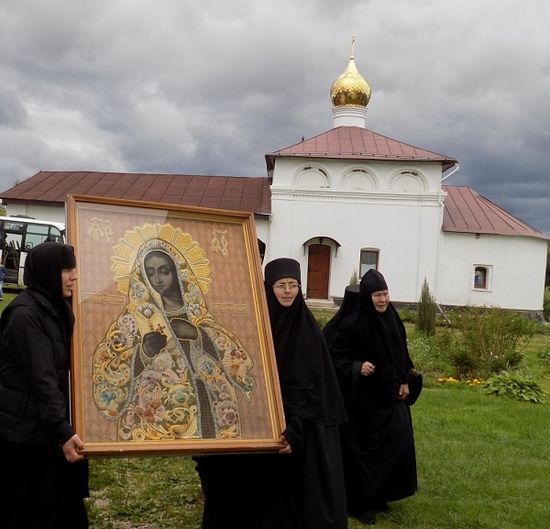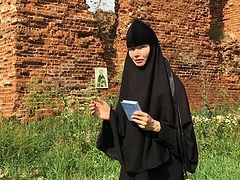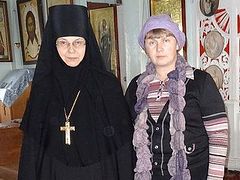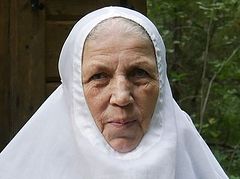Once we were serving the All-Night Vigil at the monastery. The sisters of the monastery were praying quietly. Suddenly a tall, elderly man with the deportment of a former soldier literally burst into the church. He confidently went up to the kliros and thunderously asked: “Where is your icon of St. Nadezhda?!...”
 The head sister of Gremyachevo Monastery, Nun Mikhaila
The head sister of Gremyachevo Monastery, Nun Mikhaila
Following our first article on her journey to the monastic life, we here publish more stories from Nun Mikhaila (Osipova), the head sister of Gremyachevo-Holy Dormition Monastery.
Our Gremyachevo-Holy Dormition Monastery is a dependency of the St. Nicholas-Chernoostrovsky Monastery, located in the village of Gremyachevo in the Peremyshl Region of the Kaluga Province. The sisters of the monastery are gathering interesting and edifying stories, and I would like to tell you some of them.
The Ancient Patericon and our days
Here is a story from the Ancient Patericon. Once the abbot of a desert monastery was presented with a beautiful cluster of grapes. He was sorry to eat the treat himself, but the cluster was not enough for the entire brotherhood, so he decided to treat one feeble brother with the grapes, who turned around and gave them to a sick monk, and the sick monk gave them to the elder, and so, having made their way through the brotherhood, the grapes returned again to the elder.
Something similar happened with us, as if demonstrating to us that the stories of the Patericon are still relevant, for the Lord is the same yesterday, today, and forever (Heb. 13:8).
The sisters of the monastery really love handiwork, and we undertook to embroider a large icon of the All-Holy Trinity in Gremyachevo in the winter evenings. It’s a very joyous and grace-filled but difficult and painstaking work. We embroidered the whole year. Finally, on the feast of the Holy Trinity [Pentecost—Trans.], we solemnly presented the icon to our Abbess Nikolaya. We put our whole hearts into the gift, and Mother really liked it.
Soon everyone’s beloved elder came to the dependency—Schema-Archimandrite Iliy. The sisters from Maloyaroslavets came to Gremyachevo for the feast, and Mother presented the elder with the embroidered icon as a gift after the service and trapeza.
The elder venerated the icon of the All-Holy Trinity in tears, but, in turn, blessed all the sisters with the holy icon and said he wanted to leave it as a blessing for our monastery that was reviving from the ruins.
The icon now stands on the High Place in the St. John the Theologian side altar in our church, and the sisters can see the fruit of their labors through the open Royal Doors and feel the love and care of the elder and our abbess.
St. Paisios the Athonite said: “When a man receives something, he experiences human joy, but when he gives it—Divine joy!”
Ora et labora
“Ora et labora”—”Pray and labor”—these words of St. Benedict of Nursia (480-547) are the foundation of the monastic life. Prayer and labor are the two oars by which the monk guides his boat to the shore of salvation.
Our Gremyachevo Monastery has a small subsidiary farm: a small vegetable garden, a small apple orchard, a small potato field, several beehives, and several goats and chickens. Of course, our produce is not enough for the needs of all the sisters and pilgrims.
But we noticed something amazing. Once we begin to do something, to labor at least a little, then the Lord, Who once multiplied the five loaves, sends us His blessing.
For example, in early spring we begin to plant tomato seedlings, but before these seedlings can even grow and strengthen, someone brings us a gift of greenhouse tomatoes.
Or potatoes: You work hard to dig even a small field, you plant however many potatoes you have, and the neighboring “Mayak” farm provides the monastery with the necessary vegetables all winter long.
But if you’re lazy and rely on someone else’s harvest, you’ll go completely without potatoes. The Lord thereby shows us that it pleases Him if we labor.
Akathist in the potato field
One autumn, the sisters and I all went out to dig potatoes in the field. We had just gotten to work when one of our parishioners called, who was expecting a child: “Sisters, please pray for a safe birth. I’m in the maternity hospital now.”
We all dropped out shovels; one of the sisters had a small book of Akathists with her, and we opened to the Akathist to the Mother of God “Helper in Childbirth.” We all lined up facing eastward and enthusiastically began to sing and pray to the Most Holy Theotokos.
There were bright autumn colors all around, the sun was shining, the sky was blue, and the birds were chirping: “Thy Temple, O Lord, is in Heaven, but Earth is also Thy shelter!”
We had just finished slowly singing to the end of “O My Most Blessed Queen” when we received a message: “Daughter, 7 lbs., 11 oz. Thank you for your prayers!”
And we again took up our shovels and started digging potatoes, only with even greater joy and thankfulness to God.
How cedars grew here
There was no fence at our monastery yet. There was an ancient, dilapidated wall, but we didn’t know yet if it could be restored and what funds we could do it with.
Then we began dreaming about planting a hedge of coniferous trees around the monastery. We tried to bring fir and pine saplings from the forest, but they didn’t take root well here.
In April we went to Optina on the day of the memory of the Paschal martyrs—Fr. Vasily, Fr. Trophim, and Fr. Therapont. We prayed, and on the way back we stopped to take care of some business in Kaluga, and then to the Galanthus nursery. We asked our good friend, the director of the nursery Oleg Gennadievch, to sell us three cedars, having decided to plant them in memory of the three Optina fathers. He took us to his plantations, chose the three most beautiful cedars, and then gifted them to us.
We returned to the monastery and planted the trees along the wall of the monastery, near the place where, according to tradition, the Most Holy Theotokos appeared to the pious Tsar Alexei Mikhailovich Tishaishy. The tsar had gone on pilgrimage to Kiev and stopped to rest in our ancient monastery, founded in the fourteenth century, and was accounted worthy of a miraculous vision, after which he donated gold for the construction of the Dormition Cathedral; and the place of the appearance became known as the place “Of the Conversation.”
We had just planted the cedars when our good friend Elena from Moscow called us that evening: “Sisters, it will be my birthday soon, a jubilee year. I’d like to make a worthy gift for myself—not some useless trinket, but something real, spiritual. What can I buy for the monastery?”
We told her we were dreaming of a hedge and had even bought three cedars already. But we still needed many more trees for such a hedge and we weren’t counting on such a number. Elena replied: “Wonderful! I’ll give you some cedars!”
A few days later, to our great surprise and joy, a car came to the monastery from the nursery with seedlings lovingly wrapped in burlap. There were so many, a hundred of them, that it was enough for our entire hedge. We all spent an entire week planting the cedars in the stony monastery ground and generously watered them. And there was a miracle: Every single tree survived—not a single one died!
It’s very touching that the Lord and the Most Holy Theotokos help us through kind people. Even in our days the Mother of God has appeared to local residents and our helpers in the monastery.
Help from the Most Holy Theotokos
Once a couple visited us who were married for a long time but had no children and had nearly lost all hope already. Entering the monastery, they (in their own words) came to a dead stop before the destroyed bell tower, themselves unable to understand what was happening with them. They recalled later: “Something came down on us, like a cloud, and we couldn’t recover for a long time; we couldn’t even move.”
This happened on the same place where the Most Holy Theotokos appeared to the pious tsar. They visited us again a year later, joyful and happy: They had had their firstborn, and later other children came along.
We dream of building a small chapel here in memory of the presence of the Mother of God, so everyone can feel that they are in her motherly embrace. We would be very grateful if someone would help us.
Cross procession
Cross processions are a wonderful ancient custom, especially beloved in Holy Rus’. We go out on major feasts together with our parishioners with crosses, banners, and icons to the holy spring, sprinkling holy water all around. It’s always a great joy for adults and children alike.
But the monastery also has a daily cross procession, for its protection from enemies both visible and invisible. We felt this power when we were in Maloyaroslavets.[1] At the beginning of our monastic life, some hooligans, robbers, climbed through the monastery fence and scared all the sisters. But after a trip to Diveyevo, we started going around the monastery with prayer, and uninvited guests stopped visiting us altogether.
And in Gremyachevo we also circle the monastery every day in a cross procession. But one time there was a lot of hustle and bustle (it was a big feast), and we didn’t go around with prayer. That same night, several chickens and roosters disappeared. When we called our аbbess to report the loss, the first thing she asked was: “Did you go on the cross procession?”
Since then, we try to never miss the cross procession and not forsake prayer to the Most Holy Theotokos and the Great Martyr George the Victorious who protect their little lot. In 2009, we were given a piece of the relics of St. George, brought from Holy Mount Athos.
Wonderworking icons
It’s interesting how the Lord and the Most Holy Theotokos themselves send icons to us. One woman from Kaluga spent a long time making a beaded icon for us. It’s a blessed work, living prayer, and the process of work is the joy of communication with God and the saints. This needlewoman had sewn several and then thought: “Why do I have so many icons? What will I do with them?”
She heard a voice in a dream: “Take the icons to Gremyachevo!”
She had never heard of such a place. She started asking people and found out about the monastery and gladly brought us the icons. Batiushka blessed them, and now we take them in every cross procession around the monastery.
The last hope
We got an icon of the holy Martyr Nadezhda in a similar way. Once we were serving the All-Night Vigil in the monastery and the sisters were quietly praying. Suddenly a tall, elderly man with the deportment of an ex-soldier literally burst into the church, confidently walked up to the kliros and sternly asked: “Where’s the icon of St. Nadezhda here?”
I answered in a whisper: “We don’t have one in this church.”
“How is that possible?!” he thundered. “I brought it here myself!”
It turns out it was a small icon, darkened from age, and we found it in St. George’s Church with other icons awaiting restoration. You should have seen how he rejoiced! He began to excitedly tell us that he was a former soldier named Sergei living in Moscow, and that three years ago his wife got seriously ill: Her cancer was advancing and the doctors couldn’t do anything to help.
Some believers advised him to go around to monasteries and order forty Liturgies for the health of his ailing wife. They headed out for some monasteries and stopped by ours. When they returned to Moscow, the former soldier heard a formidable order in a dream that same night: “Take the icon to Gremyachevo!”
Waking up, Sergei couldn’t understand for quite a while: What icon?! His family was far from the Church; they didn’t have any icons in the house. Then he remembered that his soldiers cleared out a basement once and found a small, darkened icon there. The image was barely visible, but they managed to read the inscription: “St. Nadezhda.”
Sergei took the icon—his last hope[2]—from a bookcase, forgotten there among the books, and took it to Gremyachevo. Without saying anything, he gave it to the sisters. And a miracle occurred! The disease left his wife. Then both of them, joyous and happy, came to Gremyachevo to thank to the merciful God and St. Nadezhda.
How two saints came to us
Since we’re already talking about cancer, I cannot but tell this story: One summer, Archpriest Serge Lukianov from America stayed with us. Of course, the living conditions here are far from American standards, but Batiushka is a descendant of Russian emigrants, so he didn’t notice any inconveniences. We traveled with him to all the surrounding holy places, and in the Optina Hermitage, the abbot gave him an icon with a particle of the relics of the venerable Optina Elders.
As he was leaving, Fr. Serge promised he would try to give us a piece of the relics of St. John of Shanghai and San Francisco, the Wonderworker, whom we love and revere. To be honest, we weren’t especially hopeful about this promise, because it’s very difficult—to get a piece of the relics of a great saint for our tiny desert monastery.
Then suddenly a year later, one of Batiushka’s friends brought us not one, but two icons with relics: St. John of Shanghai and St. Nektarios of Aegina, who, apparently, himself decided to come help us. This saint has a special grace for healing cancer, and he also especially patronizes female monasticism because he founded a convent and endured many sorrows, temptations, and slander because of it.
People have turned to us in Gremyachevo, to our life-giving healing spring, and we started reading the Akathist to St. Nektarios daily with petitions for healing for everyone who turns to him with faith.
How the Archangel Michael appeared to us
And there’s another wonderful story about an icon. Once our bishop—Metropolitan Clement of Kaluga and Borovsk—was serving in our Gremyachevo Monastery. We really wanted to please Vladyka, and we decided to give him an icon of the holy Archangel Michael painted by the sisters. We only had one icon of the Archangel Michael at that time, but we thought: Let him help our Vladyka, and by his holy prayers we will never be lost.
Before we could bid farewell and accompany our dear guest with the ringing of the bells, an unknown benefactor called us and said: “I want to donate an icon with a horseman to your monastery.”
At first we thought it was an icon of the Great Martyr George the Victorious, but when we solemnly met the holy icon, it turned out it was the Archangel Michael on a winged horse as the leader of the Heavenly Hosts. Thus the holy Archangel Michael comforted us and showed that he is always with those who love God and serve Him.
Our beloved Gremyachevo Monastery
When Vladyka Clement blessed our Abbess Nikolaya to restore Gremyachevo Monastery and we came here for the first time, we were amazed by the beauty of the local places. It’s breathtaking when you see the houses spread out below from the monastery mountain, and the beautiful Oka River, which shimmers in the sun. The name “Gremyachevo” is from the noise of the turbulent spring, a waterfall cascading from the mountain. The spring has been known since time immemorial for its crystal clear and healing water.
The first sisters who came here spent the winter in a dilapidated hut with an earthen floor. But you can’t scare our sisters with that; we preserve the precept of our elder, Schema-Archimandrite Mikhail (Balaev; † 2009), a monk of the Holy Trinity-St. Sergius Lavra: “Fear nothing!”
Even in the good old days, no more than twelve nuns labored in Gremyachevo Monastery, and now we have twelve sisters. The fate of the monastery’s older sisters was interesting: They were constantly changing here, and not because they ran away or couldn’t endure the difficulties. On the contrary, Gremyachevo became a unique forge for future abbesses and head sisters for other convents: Abbess Nektaria, Abbess Mikhaila (Kemerovo), Abbess Makaria (Volsk), Abbess Joanna (Orenburg), Nun Georgia (Saratov), Nun Elizabeth (Sharovkin Monastery).
Even in its very best times, our Gremyachevo Monastery has always been very poor, as if fulfilling the monastic oath of non-acquisitiveness and voluntary poverty. But the monastery has always helped and still helps those in need who turn to us at difficult times—perhaps not with money, but we can feed, warm, and comfort all who come to us and are surrounded by the attention and care of the sisters, and above all—of the Most Holy Theotokos.
Our monastery hasn’t had any famous benefactors, but when necessary, the Heavenly Queen herself has called people to help her monastery.
We hope that there will be kind people who will help us restore our Dormition Cathedral, which suffered in the tumultuous godless years. Its walls have not ceased “weeping” from the ammonium nitrate that saturated them. For those who help us, we will ceaselessly offer our monastic prayers to the Lord, as for “the builders, beautifiers, and pious benefactors of this holy habitation.”
We will be very glad if you come to our monastery to pray and bathe in our miraculous spring.
***
Holy Dormition-Gremyachevo Monastery contacts and details:
Address: Holy Dormition-Gremyachevo Convent, 249121, Kaluga Oblast, Peremyshl Region, Gremyachevo village
Telephone: +7 (980) 511-07-23
E-mail: gremyachevo2011@yandex.ru
Website: http://gremyachev.ru/
For donations:
Sberbank card number: 639002229005807514, Osipova Olga Egvenievna
To telephone number: +7 (980) 511-07-23
Postal: 249121, Kaluga Oblast, Peremyshil Region, Gremyachevo village, Holy Dormition-Gremyachevo Monastery (249121, Калужская обл., Перемышльский р-н, село Гремячево, Свято-Успенский Гремячев монастырь)
Bank transfers:
Russian Orthodox Church Moscow Patriarchate, Kaluga Diocesan Administration (Русская Православная Церковь Московский Патриархат, Калужское епархиальное управление)
Dependency of St. Nicholas-Chernoostrovsky Monastery in Maloyaroslavets (Подворье Свято-Никольского Черноостровского женского монастыря в г. Малоярославце)
Holy Dormition-Gremyachevo Monastery
ИНН/КПП 4001055592/400101001
БИК 042908612
р/с 40703810022240003982
к/с 30101810100000000612
In Kaluga OSB # 8608, Kaluga (в Калужском ОСБ № 8608, г. Калуга)
Names for prayer can be sent by SMS, e-mail, or mail. We can serve a moleben for you at the icons with relics of St. Nektarios of Aegina, St. John of Shanghai and San Francisco, the holy Great Martyr George the Victorious, and pray for you to the holy Archangel Michael and the Most Holy Theotokos, who has appeared on the site our monastery several times.










